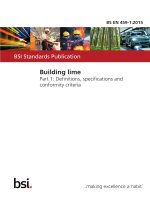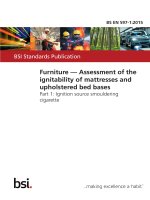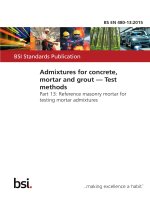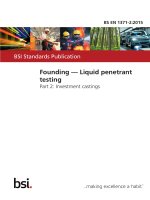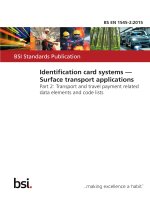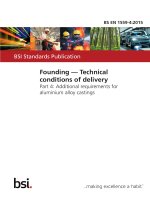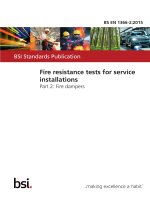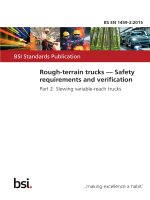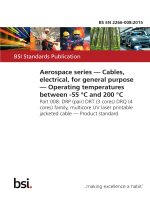Bsi bs en 62271 104 2015
Bạn đang xem bản rút gọn của tài liệu. Xem và tải ngay bản đầy đủ của tài liệu tại đây (2.09 MB, 54 trang )
BS EN 62271-104:2015
BSI Standards Publication
High-voltage switchgear
and controlgear
Part 104: Alternating current switches
for rated voltages higher than 52 kV
BRITISH STANDARD
BS EN 62271-104:2015
National foreword
This British Standard is the UK implementation of EN 62271-104:2015. It
is identical to IEC 62271-104:2015. It supersedes BS EN 62271-104:2009
which is withdrawn.
The UK participation in its preparation was entrusted by Technical
Committee PEL/17, Switchgear, controlgear, and HV-LV co-ordination, to
Subcommittee PEL/17/1, High-voltage switchgear and controlgear.
A list of organizations represented on this committee can be obtained on
request to its secretary.
This publication does not purport to include all the necessary provisions of
a contract. Users are responsible for its correct application.
© The British Standards Institution 2015.
Published by BSI Standards Limited 2015
ISBN 978 0 580 84955 8
ICS 29.130.10; 29.130.99
Compliance with a British Standard cannot confer immunity from
legal obligations.
This British Standard was published under the authority of the
Standards Policy and Strategy Committee on 31 March 2015.
Amendments/corrigenda issued since publication
Date
Text affected
BS EN 62271-104:2015
EUROPEAN STANDARD
EN 62271-104
NORME EUROPÉENNE
EUROPÄISCHE NORM
March 2015
ICS 29.130.10; 29.130.99
Supersedes EN 62271-104:2009
English Version
High-voltage switchgear and controlgear - Part 104: Alternating
current switches for rated voltages higher than 52 kV
(IEC 62271-104:2015)
Appareillage à haute tension - Partie 104: Interrupteurs à
courant alternatif pour tensions assignées supérieures à 52
kV
(IEC 62271-104:2015)
Hochspannungs-Schaltgeräte und -Schaltanlagen - Teil
104: Wechselstrom-Lastschalter für
Bemessungsspannungen über 52 kV
(IEC 62271-104:2015)
This European Standard was approved by CENELEC on 2015-03-12. CENELEC members are bound to comply with the CEN/CENELEC
Internal Regulations which stipulate the conditions for giving this European Standard the status of a national standard without any alteration.
Up-to-date lists and bibliographical references concerning such national standards may be obtained on application to the CEN-CENELEC
Management Centre or to any CENELEC member.
This European Standard exists in three official versions (English, French, German). A version in any other language made by translation
under the responsibility of a CENELEC member into its own language and notified to the CEN-CENELEC Management Centre has the
same status as the official versions.
CENELEC members are the national electrotechnical committees of Austria, Belgium, Bulgaria, Croatia, Cyprus, the Czech Republic,
Denmark, Estonia, Finland, Former Yugoslav Republic of Macedonia, France, Germany, Greece, Hungary, Iceland, Ireland, Italy, Latvia,
Lithuania, Luxembourg, Malta, the Netherlands, Norway, Poland, Portugal, Romania, Slovakia, Slovenia, Spain, Sweden, Switzerland,
Turkey and the United Kingdom.
European Committee for Electrotechnical Standardization
Comité Européen de Normalisation Electrotechnique
Europäisches Komitee für Elektrotechnische Normung
CEN-CENELEC Management Centre: Avenue Marnix 17, B-1000 Brussels
© 2015 CENELEC All rights of exploitation in any form and by any means reserved worldwide for CENELEC Members.
Ref. No. EN 62271-104:2015 E
BS EN 62271-104:2015
EN 62271-104:2015
-2-
Foreword
The text of document 17A/1079/FDIS, future edition 2 of IEC 62271-104, prepared by SC 17A “Highvoltage switchgear and controlgear” of IEC TC 17 “Switchgear and controlgear" was submitted to the
IEC-CENELEC parallel vote and approved by CENELEC as EN 62271-104:2015.
The following dates are fixed:
•
latest date by which the document has to be
implemented at national level by
publication of an identical national
standard or by endorsement
(dop)
2015-12-12
•
latest date by which the national
standards conflicting with the
document have to be withdrawn
(dow)
2018-03-12
This document supersedes EN 62271-104:2009.
Attention is drawn to the possibility that some of the elements of this document may be the subject of
patent rights. CENELEC [and/or CEN] shall not be held responsible for identifying any or all such
patent rights.
Endorsement notice
The text of the International Standard IEC 62271-104:2015 was approved by CENELEC as a
European Standard without any modification.
In the official version, for Bibliography, the following notes have to be added for the standards indicated:
IEC 60137
NOTE
Harmonized as EN 60137.
IEC 60059
NOTE
Harmonized as EN 60059.
IEC 62271-101
NOTE
Harmonized as EN 62271-101.
BS EN 62271-104:2015
EN 62271-104:2015
-3-
Annex ZA
(normative)
Normative references to international publications
with their corresponding European publications
The following documents, in whole or in part, are normatively referenced in this document and are
indispensable for its application. For dated references, only the edition cited applies. For undated
references, the latest edition of the referenced document (including any amendments) applies.
NOTE 1 When an International Publication has been modified by common modifications, indicated by (mod), the relevant
EN/HD applies.
NOTE 2 Up-to-date information on the latest versions of the European Standards listed in this annex is available here:
www.cenelec.eu.
Publication
IEC 60050-441
Year
1984
IEC 60071
IEC 60071-1
series
-
IEC 60270
-
IEC 62271-1
2007
+A1
IEC 62271-100
2011
2008
+A1
IEC 62271-102
2012
2001
+A1
+A2
IEC 62271-110
2011
2013
2012
Title
International Electrotechnical Vocabulary
(IEV) -- Chapter 441: Switchgear,
controlgear and fuses
Insulation co-ordination
Insulation co-ordination -- Part 1:
Definitions, principles and rules
High-voltage test techniques - Partial
discharge measurements
High-voltage switchgear and controlgear -Part 1: Common specifications
EN/HD
-
Year
-
EN 60071
EN 60071-1
series
-
EN 60270
-
EN 62271-1
2008
+A1
High-voltage switchgear and controlgear -- EN 62271-100
Part 100: Alternating current circuitbreakers
+A1
High-voltage switchgear and controlgear -- EN 62271-102
Part 102: Alternating current disconnectors
and earthing switches
+EN 62271102:2002/corrigend
um Jul. 2008
+EN 62271102:2002/corrigend
um Mar. 2005
+A1
+A2
High-voltage switchgear and controlgear -- EN 62271-110
Part 110: Inductive load switching
2011
2009
2012
2002
2008
2005
2011
2013
2012
BS EN 62271-104:2015
–2–
IEC 62271-104:2015 IEC 2015
CONTENTS
1
General ......................................................................................................................... 8
1.1
Scope ................................................................................................................... 8
1.2
Normative references ............................................................................................ 9
2
Normal and special service conditions ............................................................................ 9
3
Terms and definitions .................................................................................................... 9
3.1
General terms ....................................................................................................... 9
3.2
Assemblies ........................................................................................................... 9
3.3
Parts of assemblies ............................................................................................... 9
3.4
Switching devices ............................................................................................... 10
3.6
Operation ............................................................................................................ 11
3.7
Characteristic quantities ...................................................................................... 11
4
Ratings ........................................................................................................................ 13
4.1
4.2
4.3
4.4
4.5
4.6
4.7
4.8
4.10
4.11
4.101
Rated voltage (U r ) ............................................................................................... 13
Rated insulation level .......................................................................................... 13
Rated frequency (f r ) ............................................................................................ 13
Rated normal current and temperature rise (I r ) .................................................... 13
Rated short-time withstand current (I k ) ................................................................ 13
Rated peak withstand current (I p ) ........................................................................ 13
Rated duration of short-circuit (t k ) ....................................................................... 13
Rated supply voltage of closing and opening devices and of auxiliary and
control circuits (U a ) ............................................................................................. 13
Rated supply frequency of closing and opening devices and of auxiliary
circuits ................................................................................................................ 13
Rated pressure of compressed gas supply for controlled pressure systems .......... 14
Rated filling levels for insulation and/or operation ................................................ 14
Rated earth fault breaking current ....................................................................... 14
4.102
Rated short-circuit making current ....................................................................... 14
4.103
Rated mainly active load-breaking current ........................................................... 14
4.104
Rated closed-loop breaking current ..................................................................... 14
4.105
Rated capacitive switching currents ..................................................................... 14
4.9
4.105.1
Rated line-charging breaking current ............................................................ 14
4.105.2
Rated cable-charging breaking current ......................................................... 14
4.105.3
Rated single capacitor bank breaking current ................................................ 14
4.105.4
Rated back-to-back capacitor bank breaking current ..................................... 14
4.105.5
Single capacitor bank inrush making current ................................................. 15
4.105.6
Rated back-to-back capacitor bank inrush making current ............................. 15
4.105.7
Rated cable and line-charging breaking current under earth fault
conditions ........................................................................................................... 15
4.106
Inductive load switching ...................................................................................... 15
4.106.1
Shunt reactor breaking current ..................................................................... 15
4.106.2
Rated no-load transformer breaking current .................................................. 15
4.107
Rated mechanical terminal load ........................................................................... 15
4.108
Coordination of rated values for a general-purpose switch .................................... 15
4.109
Coordination of rated values for limited-purpose and special-purpose
switches ...................................................................................................................... 16
BS EN 62271-104:2015
IEC 62271-104:2015 IEC 2015
5
–3–
Design and construction .............................................................................................. 16
5.1
5.2
5.3
5.4
5.5
5.6
5.7
5.8
5.9
5.10
5.11
5.12
5.13
5.14
5.15
5.16
5.17
5.18
5.19
5.20
5.101
Requirements for liquids in high-voltage switches ................................................ 16
Requirements for gases in high-voltage switches ................................................. 16
Earthing of high-voltage switches ........................................................................ 17
Auxiliary and control equipment ........................................................................... 17
Dependent power operation ................................................................................. 17
Stored energy operation ...................................................................................... 17
Independent manual or power operation (independent unlatched operation) ......... 17
Operation of releases .......................................................................................... 17
Low- and high-pressure interlocking and monitoring devices ................................ 17
Nameplates ......................................................................................................... 17
Interlocking devices ............................................................................................ 18
Position indication ............................................................................................... 19
Degree of protection provided by enclosures........................................................ 19
Creepage distances for outdoor insulators ........................................................... 19
Gas and vacuum tightness .................................................................................. 19
Liquid tightness ................................................................................................... 19
Fire hazard (flammability) .................................................................................... 19
Electromagnetic compatibility (EMC) .................................................................... 19
X-ray emission .................................................................................................... 19
Corrosion ............................................................................................................ 19
Closing mechanism ............................................................................................. 19
5.102
Mechanical strength ............................................................................................ 19
5.103
Position of the movable contact system and its indicating or signalling device ...... 19
5.103.1
Securing the position ................................................................................... 19
5.103.2
Indication of position .................................................................................... 20
5.103.3
Auxiliary contacts for signalling .................................................................... 20
6
Type tests ................................................................................................................... 20
6.1
6.2
6.3
6.4
6.5
6.6
6.7
6.8
6.9
6.10
6.11
6.101
General ............................................................................................................... 20
Dielectric tests .................................................................................................... 21
Radio interference voltage (r.i.v.) tests ................................................................ 22
Measurement of the resistance of circuits ............................................................ 22
Temperature rise tests ........................................................................................ 22
Short-time withstand current and peak withstand current tests ............................. 22
Verification of the protection ................................................................................ 22
Tightness tests .................................................................................................... 22
Electromagnetic compatibility tests (EMC) ........................................................... 22
Additional tests on auxiliary and control circuits ................................................... 22
X-radiation test procedure for vacuum interrupters ............................................... 22
Mechanical operation tests .................................................................................. 22
6.101.1
Arrangement of the switch for tests .............................................................. 22
6.101.2
Tests for general-purpose switches .............................................................. 23
6.101.3
Tests for limited-purpose and special-purpose switches ................................ 24
6.101.4
Condition of switch during and after mechanical operation tests .................... 24
6.101.5
Operation under severe ice conditions .......................................................... 24
6.101.6
Static terminal load tests .............................................................................. 24
6.102
Miscellaneous provision for making and breaking tests ........................................ 25
6.102.1
Arrangement of the switch for tests .............................................................. 25
BS EN 62271-104:2015
–4–
IEC 62271-104:2015 IEC 2015
Behaviour of switch during breaking tests ..................................................... 26
6.102.2
6.102.3
Condition of switch after breaking tests ........................................................ 26
6.102.4
Condition of switch during and after short-circuit making tests ....................... 26
6.103
Test circuits for making and breaking tests .......................................................... 27
6.103.1
6.103.2
6.103.3
6.103.4
6.103.5
6.103.6
6.104
General ....................................................................................................... 27
Earthing of test circuit and switch ................................................................. 27
Mainly active load circuit (test duty 1 and test duty 3) ................................... 28
Closed-loop circuits (test duty 2) .................................................................. 31
Test circuits for short-circuit making tests (test duty 6) .................................. 35
Test circuits for breaking tests under earth fault conditions (test duties
7a and 7b) .................................................................................................... 37
Test quantities .................................................................................................... 37
6.104.1
Test frequency ............................................................................................. 37
6.104.2
Test voltage for breaking tests ..................................................................... 37
6.104.3
Breaking current .......................................................................................... 38
6.104.4
Test voltage for short-circuit making tests ..................................................... 39
6.104.5
Short-circuit making current.......................................................................... 40
6.105
Capacitive current switching tests ........................................................................ 40
6.105.1
Applicability ................................................................................................. 40
6.105.2
General ....................................................................................................... 41
6.105.3
Characteristics of supply circuits .................................................................. 41
6.105.4
Earthing of the supply circuit ........................................................................ 41
6.105.5
Characteristics of the capacitive circuit to be switched .................................. 41
6.105.6
Waveform of the current ............................................................................... 41
6.105.7
Test voltage ................................................................................................. 41
6.105.8
Test current ................................................................................................. 42
6.105.9
Test duties ................................................................................................... 42
6.105.10
Tests with specified TRV .............................................................................. 43
6.105.11
Criteria to pass the test ................................................................................ 43
6.106
Inductive load switching (test duty 5) ................................................................... 43
6.106.1
No-load transformer circuit (test duty 5a) ...................................................... 43
6.106.2
Shunt-reactor current switching tests (test duty 5b) ....................................... 43
6.107
Tests for general-purpose switches ..................................................................... 44
6.108
Tests for limited-purpose switches ....................................................................... 45
6.109
Tests for special-purpose switches ...................................................................... 45
6.110
Type test reports ................................................................................................. 45
7
Routine tests ............................................................................................................... 46
7.1
7.2
7.3
7.4
7.5
7.101
8
Dielectric tests on main circuit ............................................................................. 46
Tests on auxiliary and control circuits .................................................................. 46
Measurement of the resistance of the main circuit ................................................ 46
Tightness test ..................................................................................................... 46
Design and visual checks .................................................................................... 46
Mechanical operating tests .................................................................................. 46
Guide to the selection of high-voltage switches ............................................................ 47
8.1
8.2
8.101
Selection of rated values ..................................................................................... 47
Continuous or temporary overload due to changed service conditions .................. 47
General ............................................................................................................... 47
8.102
Conditions affecting application ........................................................................... 47
BS EN 62271-104:2015
IEC 62271-104:2015 IEC 2015
8.103
9
–5–
Insulation coordination ........................................................................................ 47
Information to be given with enquiries, tenders and orders ............................................ 48
9.1
Information with enquiries and orders .................................................................. 48
9.2
Information with tenders ...................................................................................... 48
10 Transport, storage, installation, operation and maintenance.......................................... 48
11
Safety ......................................................................................................................... 48
12
Influence of the high-voltage switch on the environment ............................................... 48
Bibliography ....................................................................................................................... 49
Figure 1 – Single-phase test circuit for mainly active load current switching for test
duties 1 and 3 ..................................................................................................................... 28
Figure 2 – Single-phase test circuit for transmission line closed loop and paralleltransformer current switching test, for test duties 2a and 2b ................................................. 28
Figure 3 – Three-phase test circuit for mainly active load current switching, for test
duties 1 and 3 ..................................................................................................................... 29
Figure 4 – Supply and load side transient for mainly active load current switching tests
(see Table 4) ...................................................................................................................... 30
Figure 5 – Three-phase test circuit for transmission line closed loop and paralleltransformer current switching test for test duties 2a and 2b .................................................. 31
Figure 6 – Illustration of the transient associated with transmission line closed loop
current breaking tests (see Table 5) .................................................................................... 33
Figure 7 – Three-phase test circuit for short circuit making current test for test duty 6 .......... 36
Figure 8 – Single-phase test circuit for short circuit making current test for test duty 6 ......... 36
Table 1 – Preferred values of line- and cable-charging breaking currents for a generalpurpose switch ................................................................................................................... 16
Table 2 – Nameplate information ......................................................................................... 18
Table 3 – Type tests ........................................................................................................... 21
Table 4 – Supply circuit TRV parameters for mainly active load current breaking tests ......... 30
Table 5 – TRV parameters for transmission line closed loop current breaking tests .............. 32
Table 6 – Test duties for single-phase tests on three-pole switches having a nonsimultaneity between poles of 0,25 cycle or less .................................................................. 33
Table 7 – Test duties for single-phase tests on three-pole switches having more than
0,25 cycle non-simultaneity and switches operated pole after pole ....................................... 34
Table 8 – TRV parameters for parallel transformer current breaking tests............................. 35
Table 9 – Test duties for three-phase tests on three-pole switches ...................................... 37
BS EN 62271-104:2015
–8–
IEC 62271-104:2015 IEC 2015
HIGH-VOLTAGE SWITCHGEAR AND CONTROLGEAR –
Part 104: Alternating current switches
for rated voltages higher than 52 kV
1
1.1
General
Scope
Subclause 1.1 of IEC 62271-1:2007 is not applicable, and is replaced as follows:
This part of IEC 62271 is applicable to three-pole alternating current switches for rated
voltages higher than 52 kV, having making and breaking current ratings, for indoor and
outdoor installations, and for rated frequencies up to and including 60 Hz.
This standard is also applicable to the operating devices of these switches and to their
auxiliary equipment.
NOTE 1 Switches for gas insulated switchgear are covered by this standard.
NOTE 2 Switches having a disconnecting function and called switch-disconnectors are also covered by IEC 62271102.
NOTE 3 Earthing switches are not covered by this standard. Earthing switches forming an integral part of a switch
are covered by IEC 62271-102.
The main object of this standard is to establish requirements for switches used in
transmission and distribution systems. General-purpose switches for this application are
designed to comply with the following service applications:
–
arrying rated normal current continuously;
–
carrying short-circuit currents for a specified time;
–
switching of mainly active loads;
–
switching of no-load transformers;
–
switching of the charging current of unloaded cables, overhead lines or busbars;
–
switching of closed-loop circuits;
–
making short-circuit currents.
A further object of this standard is to establish requirements for limited-purpose and specialpurpose switches used in transmission and distribution systems.
Limited-purpose switches comply with one or more of the service applications indicated
above.
Special-purpose switches may comply with one or more of the service applications indicated
above and, in addition, are suitable for one or more of the following applications:
–
switching single capacitor banks;
–
switching back-to-back capacitor banks;
–
switching shunt reactors including secondary or tertiary reactors switched from the primary
side of the transformer;
–
applications requiring an increased number of operating cycles;
–
switching under earth fault conditions in non-effectively earthed neutral systems.
BS EN 62271-104:2015
IEC 62271-104:2015 IEC 2015
1.2
–9–
Normative references
The following documents, in whole or in part, are normatively referenced in this document and
are indispensable for its application. For dated references, only the edition cited applies. For
undated references, the latest edition of the referenced document (including any
amendments) applies.
IEC 60050-441:1984, International Electrotechnical Vocabulary – Chapter 441: Switchgear,
controlgear and fuses
IEC 60071 (all parts), Insulation co-ordination
IEC 60071-1, Insulation co-ordination – Part 1: Definitions, principles and rules
IEC 60270, High-voltage test techniques – Partial discharge measurements
IEC 62271-1:2007, High-voltage switchgear and controlgear – Part 1: Common specifications
IEC 62271-1:2007/AMD1:2011
IEC 62271-100:2008, High-voltage switchgear and controlgear – Part 100: Alternating-current
circuit-breakers
IEC 62271-100:2008/AMD1:2012
IEC 62271-102:2001, High-voltage switchgear and controlgear – Part 102: Alternating current
disconnectors and earthing switches
IEC 62271-102:2001/AMD1:2011
IEC 62271-102:2001/AMD2:2013
IEC 62271-110:2012, High-voltage switchgear and controlgear – Part 110: Inductive load
switching
2
Normal and special service conditions
Clause 2 of IEC 62271-1:2007/AMD 1:2011 is applicable.
3
Terms and definitions
Clause 3 of IEC 62271-1:2007 is applicable with the the following additions.
For the purposes of this document, definitions of general terms are based on IEC 60050-441
and IEC 60071-1.
Additional terms and definitions are based solely on IEC 60050-441.
3.1
General terms
Subclause 3.1 of IEC 62271-1:2007 is applicable.
3.2
Assemblies
Subclause 3.2 of IEC 62271-1:2007 is applicable.
3.3
Parts of assemblies
Subclause 3.2 of IEC 62271-1:2007 is applicable.
BS EN 62271-104:2015
– 10 –
3.4
IEC 62271-104:2015 IEC 2015
Switching devices
Subclause 3.4 of IEC 62271-1:2007 is applicable, with the following additions.
3.4.101
switch
switching device capable of making, carrying and breaking currents under normal circuit
conditions, which may include specified operating overload conditions and also carrying for a
specified time currents under specified abnormal circuit conditions, such as those of shortcircuit
[SOURCE: IEC 60050-441:1984, 441-14-10, modified – deletion of the word "mechanical" in
the definition and deletion of the note.]
3.4.102
switch-disconnector
switch which, in the open position, satisfies the isolating requirements specified for a
disconnector
[SOURCE: IEC 60050-441:1984, 441-14-12]
3.4.103
general-purpose switch
switch capable of performing, with currents up to its rated breaking currents, all making and
breaking operations which may normally occur; capable of carrying and making short-circuit
currents
Note 1 to entry:
Refer to 4.108 for specific ratings of a general-purpose switch.
3.4.104
limited-purpose switch
switch which complies with one or more, but not with all, service applications of a generalpurpose switch
3.4.105
special-purpose switch
switch suitable for switching requirements other than those specified for a general-purpose
switch
Note 1 to entry: Examples of such requirements are capacitor bank switching, shunt reactor switching, switching
under earth fault conditions, and a capability of an increased number of operating cycles.
3.4.106
class C1 switch
special-purpose switch with low probability of restrike during capacitive current breaking as
demonstrated by specific type tests
3.4.107
class C2 switch
special-purpose switch with very low probability of restrike during capacitive current breaking
as demonstrated by specific type tests
3.4.108
single capacitor bank switch
special-purpose switch intended for switching of a single capacitor bank with charging
currents up to its rated single capacitor bank breaking current
BS EN 62271-104:2015
IEC 62271-104:2015 IEC 2015
– 11 –
3.4.109
back-to-back capacitor bank switch
special-purpose switch intended for breaking capacitor bank-charging currents, with one or
more capacitor banks connected to the bus or supply side of the switch, up to its rated backto-back capacitor bank breaking current
3.4.110
shunt reactor switch
special-purpose switch intended for switching a shunt reactor, including secondary or tertiary
reactors switched from the primary side of the transformer
3.5
Parts of switches
Subclause 3.5 of IEC 62271-1:2007 is applicable.
3.6
Operation
Subclause 3.6 of IEC 62271-1:2007 is applicable.
3.7
Characteristic quantities
Subclause 3.7 of IEC 62271-1:2007 is applicable, with the following additions.
3.7.101
breaking capacity (of a switching device or a fuse)
value of prospective current that a switching device or a fuse is capable of breaking at a
stated voltage under prescribed conditions of use and behaviour
Note 1 to entry:
publications.
The voltage to be stated and the conditions to be prescribed are dealt with in the relevant
Note 2 to entry: For switching devices, the breaking capacity may be termed according to the kind of current
included in the prescribed conditions, e.g. line-charging breaking capacity, cable charging breaking capacity, single
capacitor bank breaking capacity, etc.
[SOURCE: IEC 60050-441:1984, 441-17-08]
3.7.102
mainly active load breaking capacity
breaking capacity when opening a mainly active load circuit in which the load can be
represented by resistors and reactors in parallel
3.7.103
no-load transformer breaking capacity
breaking capacity when opening a no-load transformer circuit
3.7.104
closed-loop breaking capacity
breaking capacity when opening a closed transmission line loop circuit, or a transformer in
parallel with one or more transformers, i.e. a circuit in which both sides of the switch remain
energized after breaking, and in which the voltage appearing across the terminals is
substantially less than the system voltage
3.7.105
cable-charging breaking capacity
breaking capacity when opening a cable circuit at no load
3.7.106
line-charging breaking capacity
breaking capacity when opening an overhead line circuit at no load
BS EN 62271-104:2015
– 12 –
IEC 62271-104:2015 IEC 2015
3.7.107
busbar charging breaking capacity
breaking capacity when opening a busbar circuit at no load
3.7.108
single capacitor bank breaking capacity
breaking capacity when opening a single capacitor bank circuit connected to a supply that
does not include another capacitor bank adjacent to the bank being switched
3.7.109
back-to-back capacitor bank breaking capacity
breaking capacity when opening a capacitor bank circuit connected to a supply that includes
one or more capacitor banks adjacent to the bank being switched
3.7.110
capacitor bank inrush making current
high frequency and high magnitude current occurring when closing a capacitor bank circuit
onto a supply including one or more capacitor banks adjacent to the bank being switched
Note 1 to entry: The frequency and magnitude of the inrush current depend upon the values of capacitance and
the values of the inductance between the capacitor banks.
3.7.111
shunt reactor breaking capacity
breaking capacity when opening a shunt reactor circuit, including secondary or tertiary
reactors switched from the primary side of the transformer
3.7.112
earth-fault breaking capacity
breaking capacity in the faulty phase of a non-effectively earthed neutral system when
clearing an earth fault on an unloaded cable or overhead line on the load side of the switch
3.7.113
cable and line charging breaking capacity under earth fault conditions
breaking capacity in the sound phases of an effectively earthed neutral or non-effectively
earthed neutral system when switching off an unloaded cable or overhead line, with an earth
fault on the supply side of the switch
3.7.114
breaking current (of a switching device or a fuse)
current in a pole of a switching device or in a fuse at the instant of initiation of the arc during a
breaking process
[SOURCE: IEC 60050-441:1984 441-17-07]
3.7.115
(peak)-making current
peak value of the first major loop of the current in a pole of a switch during the transient
period following the initiation of current during a making operation
Note 1 to entry: The peak value may differ from one pole to another and from one operation to another as it
depends on the instant of current initiation relative to the wave of the applied voltage.
Note 2 to entry: Where, for a polyphase circuit, a single value of (peak) making current is referred to, it is, unless
otherwise stated, the highest value in any phase.
3.7.116
short-circuit making capacity
making capacity for which the prescribed conditions include a short-circuit at the terminals of
the switching device
BS EN 62271-104:2015
IEC 62271-104:2015 IEC 2015
– 13 –
[SOURCE: IEC 60050-441:1984, 441-17-10]
3.7.117
simultaneity between poles
maximum difference between the instant of contact touch in the first pole and the last pole
when closing and the maximum time difference between the instant of contact separation
between the first pole and the last pole when opening
4
Ratings 1
Clause 4 of IEC 62271-1:2007/AMD 1:2011 is applicable with the the following additions.
4.1
Rated voltage (U r )
Subclause 4.1 of IEC 62271-1:2007/AMD 1:2011 is applicable with the following addition:
The 1 100 kV and 1 200 kV voltage ratings do not apply to switches.
4.2
Rated insulation level
Subclause 4.2 of IEC 62271-1:2007/AMD 1:2011 is applicable.
4.3
Rated frequency (f r )
Subclause 4.3 of IEC 62271-1:2007 is applicable.
4.4
Rated normal current and temperature rise (I r )
Subclause 4.4 of IEC 62271-1:2007 is applicable.
4.5
Rated short-time withstand current (I k )
Subclause 4.5 of IEC 62271-1:2007 is applicable.
4.6
Rated peak withstand current (I p )
Subclause 4.6 of IEC 62271-1:2007/AMD 1:2011 is applicable.
4.7
Rated duration of short-circuit (t k )
Subclause 4.7 of IEC 62271-1:2007 is applicable.
4.8
Rated supply voltage of closing and opening devices and of auxiliary and control
circuits (U a )
Subclause 4.8 of IEC 62271-1:2007 is applicable.
4.9
Rated supply frequency of closing and opening devices and of auxiliary circuits
Subclause 4.9 of IEC 62271-1:2007 is applicable.
___________
1
Note concerning the rated values:
In English, the terms “rated making current” and “rated breaking current” are now used where formerly “rated
making capacity” and “rated breaking capacity” were used, the intended meaning being adequately conveyed
by the use of “rated”. In French, the terms “pouvoir de fermeture assigné” and “pouvoir de coupure assigné”
continue to be used.
BS EN 62271-104:2015
– 14 –
4.10
IEC 62271-104:2015 IEC 2015
Rated pressure of compressed gas supply for controlled pressure systems
Subclause 4.10 of IEC 62271-1:2007 is applicable.
4.11
Rated filling levels for insulation and/or operation
Subclause 4.11 of IEC 62271-1:2007 is applicable.
4.101
Rated earth fault breaking current
The rated earth fault breaking current, for a non-effectively earthed neutral system is the
maximum earth fault current in the faulted phase that the switch shall be capable of breaking
at its rated voltage.
NOTE The TRV (transient recovery voltage) of an isolated neutral system is more severe than the TRV of a
resonant earthed system, even if detuned.
4.102
Rated short-circuit making current
The rated short-circuit making current is the maximum peak prospective current that the
switch shall be capable of making at its rated voltage.
4.103
Rated mainly active load-breaking current
The rated mainly active load-breaking current is the maximum mainly active load current that
the switch shall be capable of breaking at its rated voltage.
4.104
Rated closed-loop breaking current
The rated closed-loop breaking current is the maximum closed-loop current the switch shall
be capable of breaking. Separate ratings for transmission line loop current and parallel
transformer current may be assigned.
4.105
4.105.1
Rated capacitive switching currents
Rated line-charging breaking current
The rated line-charging breaking current is the maximum line-charging current that the switch
shall be capable of breaking at its rated voltage.
4.105.2
Rated cable-charging breaking current
The rated cable-charging breaking current is the maximum cable-charging current that the
switch shall be capable of breaking at its rated voltage.
4.105.3
Rated single capacitor bank breaking current
The rated capacitor bank breaking current is the maximum capacitor current the switch shall
be capable of breaking at the rated voltage under the conditions of use and behaviour
prescribed in this standard. The breaking current refers to the switching of a shunt capacitor
bank where no shunt capacitors are connected to the source side of the switch.
4.105.4
Rated back-to-back capacitor bank breaking current
The rated back-to-back capacitor bank breaking current is the maximum capacitor bank
breaking current that the switch shall be capable of breaking at its rated voltage with one or
BS EN 62271-104:2015
IEC 62271-104:2015 IEC 2015
– 15 –
more capacitor banks connected on the supply side of the switch adjacent to the bank being
switched, such as to produce the rated capacitor bank inrush making current. This breaking
current refers to the switching of a shunt capacitor bank where one or several shunt capacitor
banks are connected to the source side of the switch giving an inrush making current equal to
the rated back-to-back capacitor bank inrush making current.
NOTE
Similar conditions could apply for switching at substations with cables.
4.105.5
Single capacitor bank inrush making current
No rating or preferred values are defined. This is because inrush currents associated with
single capacitor banks are not considered critical.
4.105.6
Rated back-to-back capacitor bank inrush making current
The rated back-to-back capacitor bank inrush making current is the peak value of the current
that the switch shall be capable of making at its rated voltage and with a frequency of the
inrush current appropriate to the service conditions (see Table 9 of IEC 62271-100:2008).
NOTE The back-to-back capacitor bank making performance is covered when
– the tested peak inrush making current is equal to or greater than the rated value, and
– the tested frequency of the inrush making current is equal to or greater than 77 % of the rated value. The
applicability of this rule is limited to frequencies below 6 000 Hz.
4.105.7
Rated cable and line-charging breaking current under earth fault conditions
The rated cable and line-charging breaking current under earth fault conditions, for a noneffectively earthed neutral system is the current in the sound phases that the switch shall be
capable of breaking at its rated voltage.
NOTE The maximum cable and line-charging current under fault conditions is √3 times the cable and line charging
current occurring in normal conditions. This covers the most severe case, which occurs with individually screened
cables.
4.106
4.106.1
Inductive load switching
Shunt reactor breaking current
The shunt reactor breaking current is the maximum shunt reactor current that the switch shall
be capable of breaking at its rated voltage.
NOTE The minimum shunt reactor breaking current, if other than zero, that the switch is capable of breaking is
specified by the manufacturer.
4.106.2
Rated no-load transformer breaking current
The rated no-load transformer breaking current is the maximum no-load transformer current
the switch shall be capable of breaking at its rated voltage.
4.107
Rated mechanical terminal load
Subclause 4.103 of IEC 62271-102:2001 is applicable.
4.108
Coordination of rated values for a general-purpose switch
A general-purpose switch shall have specific ratings for each switching duty as follows:
–
rated mainly active load breaking current equal to the rated normal current;
–
rated no-load transformer breaking current equal to 1,0 % of the rated normal current;
BS EN 62271-104:2015
– 16 –
IEC 62271-104:2015 IEC 2015
–
rated transmission line loop breaking current equal to the rated normal current;
–
rated parallel transformer breaking current equal to 50 % of the rated normal current;
–
rated cable-charging breaking current as shown in Table 1;
–
rated line-charging breaking current as shown in Table 1;
–
rated short-circuit making current equal to the rated peak withstand current.
The standard values of ratings should be selected from the R10 series specified in IEC 60059.
Table 1 – Preferred values of line- and cable-charging breaking
currents for a general-purpose switch
Rated voltage
Ur
Rated cable-charging
breaking current
I 4a
Rated line-charging breaking
current
I 4b
kV
A
A
72,5
25
3
100
31,5
5
123
31,5
8
145
31,5
20
170
40
12,5
245
40
25
300
50
31,5
362
50
50
420
63
63
550
–
80
800
–
125
NOTE 1 Higher values selected from the R10 series can be stated by the manufacturer.
NOTE 2 Refer to IEC 62271-100 for suggested rated line- and cable-charging breaking currents for a special
purpose switch.
4.109
Coordination of rated values for limited-purpose and special-purpose
switches
A limited-purpose switch should preferably have the same specific ratings as those for a
general-purpose switch, where such ratings are applicable. If other ratings are specified,
values from the R10 series should be selected.
A special-purpose switch is not required to have coordinated ratings. The rated values,
however, should be selected from the R10 series specified in IEC 60059.
5
Design and construction
Clause 5 of IEC 62271-1:2007 is applicable with the following additions.
5.1
Requirements for liquids in high-voltage switches
Subclause 5.1 of IEC 62271-1:2007 is applicable.
5.2
Requirements for gases in high-voltage switches
Subclause 5.2 of IEC 62271-1:2007 is applicable.
BS EN 62271-104:2015
IEC 62271-104:2015 IEC 2015
5.3
– 17 –
Earthing of high-voltage switches
Subclause 5.3 of IEC 62271-1:2007 is applicable.
5.4
Auxiliary and control equipment
Subclause 5.4 of IEC 62271-1:2007 is applicable.
5.5
Dependent power operation
Subclause 5.5 of IEC 62271-1:2007 is applicable.
5.6
Stored energy operation
Subclause 5.6 of IEC 62271-1:2007 is applicable.
5.7
Independent manual or power operation (independent unlatched operation)
Subclause 5.7 of IEC 62271-1:2007 is applicable.
5.8
Operation of releases
Subclause 5.8 of IEC 62271-1:2007 is applicable.
5.9
Low- and high-pressure interlocking and monitoring devices
Subclause 5.9 of IEC 62271-1:2007 is applicable.
5.10
Nameplates
Subclause 5.10 of IEC 62271-1:2007 is applicable. Switches and their operating devices shall
be provided with nameplates which contain information in accordance with Table 2.
BS EN 62271-104:2015
– 18 –
IEC 62271-104:2015 IEC 2015
Table 2 – Nameplate information
Abbreviation
Unit
Switch
Operating
device
Condition marking
required only if
(2)
(3)
(4)
(5)
(6)
Manufacturer
a
a
Designation of type
a
a
Serial number
a
a
Rated voltage
Ur
kV
a
Rated lightning impulse withstand voltage
Up
kV
a
Rated switching impulse withstand voltage
Us
kV
c
Rated frequency
fr
Hz
a
Rated normal current
Ir
A
a
Rated short-time current
Ik
kA
a
Rated duration of short circuit
tk
s
c
I ma
(1)
kA
a
N
c
I1
A
b
Rated transmission line closed loop breaking current
I 2a
A
b
Rated parallel transformer breaking current
I 2b
A
b
Rated cable-charging breaking current
I 4a
A
b
Rated line-charging breaking current
I 4b
A
b
Rated busbar charging breaking current
I 4c
A
b
Rated single capacitor bank breaking current
I 4d
A
b
Rated back-to-back capacitor bank breaking current
I 4e
A
b
Rated no-load transformer breaking current
I 5a
A
b
Rated shunt reactor breaking current
I 5b
A
b
Rated earth-fault breaking current
I 7a
A
b
Rated cable and line charging breaking current under
earth-fault conditions
I 7b
A
b
Rated back-to-back capacitor bank inrush making
current
I in
A
b
Rated filling pressure for operation
p rm
MPa
Rated filling pressure for interruption
p re
MPa
Rated auxiliary voltage
Ua
V
Mass (including liquid)
m
kg
Rated short-circuit making current
Number of operations for mainly active load breaking
Rated mainly active load breaking current
Temperature class
a
Rated voltage
≥300 kV
Different from 1 s
Different from 10
b
b
a
c
c
c
c
>300 kg
Different from
–5 °C indoor or
–25 °C outdoor
The marking of these values is mandatory; blanks for these values on the nameplate indicate the value zero.
b
The marking of these values is optional.
c
The marking of these values is subject to the condition in column (6).
NOTE 1 Abbreviations in column (2) can be used instead of terms in column (1). When terms of column (1) are used,
the word “rated” need not appear.
NOTE 2 Abbreviations can be combined where values are identical, for example: I r I 1 I 2a 400 A.
5.11
Interlocking devices
Subclause 5.11 of IEC 62271-1:2007 is applicable.
BS EN 62271-104:2015
IEC 62271-104:2015 IEC 2015
5.12
– 19 –
Position indication
Subclause 5.12 of IEC 62271-1:2007 is applicable.
5.13
Degree of protection provided by enclosures
Subclause 5.13 of IEC 62271-1:2007 is applicable.
5.14
Creepage distances for outdoor insulators
Subclause 5.14 of IEC 62271-1:2007 is applicable.
5.15
Gas and vacuum tightness
Subclause 5.15 of IEC 62271-1:2007 is applicable.
5.16
Liquid tightness
Subclause 5.16 of IEC 62271-1:2007 is applicable.
5.17
Fire hazard (flammability)
Subclause 5.17 of IEC 62271-1:2007 is applicable.
5.18
Electromagnetic compatibility (EMC)
Subclause 5.18 of IEC 62271-1:2007 is applicable.
5.19
X-ray emission
Subclause 5.19 of IEC 62271-1:2007 is applicable.
5.20
Corrosion
Subclause 5.20 of IEC 62271-1:2007 is applicable.
5.101
Closing mechanism
For switches having a short-circuit making current rating, only switches having stored energy
closing or dependent power closing mechanisms are allowed.
5.102
Mechanical strength
Switches shall be capable of bearing the rated mechanical terminal load when installed
according to the manufacturer’s instructions, as well as electromagnetic forces, without
reduction of their reliability or current-carrying capacity.
5.103
5.103.1
Position of the movable contact system and its indicating or signalling
device
Securing the position
Switches, including their operating devices, shall be so constructed that they cannot come out
of their open or closed positions by forces arising from gravity, vibration, reasonable shocks
or accidental touching of the connecting rods of their operating devices, or by electromagnetic
forces. Switches or their operating devices shall be designed to allow the application of
means to prevent unauthorized operation.
BS EN 62271-104:2015
– 20 –
5.103.2
IEC 62271-104:2015 IEC 2015
Indication of position
The open and closed positions of the switches shall be clearly indicated. This requirement is
met if one of the following conditions is fulfilled: a) the gap or isolating distance is visible; b)
the position of each movable contact is indicated by a reliable indicating device.
NOTE 1 A visible moving contact can serve as the indicating device.
NOTE 2 In some countries the design of the disconnector is such that the isolating distance is visible.
In the case where all poles of a switch are so coupled as to be operated as a single unit, it is
permissible to use a common indicating device.
5.103.3
Auxiliary contacts for signalling
Signalling of the closed position shall not take place until it is certain that the movable
contacts will reach a position in which the rated normal, peak withstand, and short-time
withstand currents can be carried safely.
Signalling of the open position shall not take place until the movable contacts have reached a
position such that the corresponding gap or isolating distance is at least 80 % of the total
isolating distance, or until it is certain that the movable contacts will reach their fully open
position.
6
Type tests
Clause 6 of IEC 62271-1:2007/AMD 1:2011 is applicable with the additions and exceptions
indicated below.
6.1
General
The type tests for switches are listed in Table 3. The number of test specimens used for the
type tests shall be in accordance with 6.1.1 of IEC 62271-1:2007.
BS EN 62271-104:2015
IEC 62271-104:2015 IEC 2015
– 21 –
Table 3 – Type tests
Mandatory type tests
Subclauses
Dielectric tests
6.2
Measurement of the resistance of main circuit
6.4
Temperature-rise tests
6.5
Short-time withstand current and peak withstand current tests
6.6
Additional tests on auxiliary and control circuits
6.10
Mechanical operation test at ambient temperature
6.101
Making and breaking tests
Type tests dependent upon application, rating or
design
6.102 and 6.107
Condition requiring type test
Subclauses
Radio interference voltage test
U r ≥ 123 kV
6.3
Verification of degree of protection
Assigned IP class
6.7
Tightness test
Controlled, sealed or closed pressure
systems
6.8
EMC tests
If electronic equipment or components
are included in the secondary system
6.9
Extended mechanical endurance tests on
switches for special purposes
Class M2 rating assigned
Low and high temperature test
Assigned temperature class
Static terminal load tests
Outdoor switches with U r > 52 kV
6.101.6
Test to prove operation under severe ice
conditions
Outdoor switches with rated ice
thickness (10 mm or 20 mm)
6.101.5
Partial discharge test
When assigned
6.2.9
Capacitive current switching tests
When assigned
6.105
Switching of inductive loads
When assigned
6.106
Breaking tests under earth fault conditions
U r < 245 kV
Tests for general-purpose switches
General-purpose switches only
6.107
Tests for limited purpose switches
Limited purpose switches only
6.108
Tests for special purpose switches
Special purpose switches only
6.109
Artificial pollution test
Outdoor switches used in polluted
areas
X-radiation test procedure for vacuum
interrupters
Vacuum interrupters only
6.101.3
6.101.3 of
IEC 62271-100:2008
6.103.6
6.2.8 of IEC 622711:2007
6.11
All of the mandatory type tests should be made on the complete high-voltage switch (filled
with the specified types and quantities of liquid or gas at specified pressure or reduced
pressure, as required), and on its operating devices and auxiliary equipment.
The high-voltage switch tested shall conform in all essential details to drawings of the type of
switch specified.
6.2
Dielectric tests
Subclause 6.2 of IEC 62271-1:2007 is applicable with the following exception:
6.2.9
Partial discharge tests
Subclause 6.2.9 of IEC 62271-1:2007 is replaced by the following:
BS EN 62271-104:2015
– 22 –
IEC 62271-104:2015 IEC 2015
No partial discharge tests are required to be performed on the complete high voltage switch.
However, in the case of switches using components for which a relevant IEC publication
exists, including partial discharge measurements (e.g., bushings, IEC 60137[1] 2), evidence
shall be produced by the manufacturer showing that these components have passed the
partial discharge tests as foreseen by the relevant IEC publication. For partial discharge
measurements, refer to IEC 60270.
6.3
Radio interference voltage (r.i.v.) tests
Radio interference voltage tests shall be performed by agreement between manufacturer and
user. Subclause 6.3 of IEC 62271-1:2007 is applicable with the following addition:
Tests may be performed on one pole of the switch in both closed and open positions.
NOTE These tests are not required for switches with rated voltages higher than 52 kV and up to 100 kV, nor for
switches used in gas- insulated substations.
6.4
Measurement of the resistance of circuits
Subclause 6.4 of IEC 62271-1:2007 is applicable.
6.5
Temperature rise tests
Subclause 6.5 of IEC 62271-1:2007 is applicable.
6.6
Short-time withstand current and peak withstand current tests
Subclause 6.6 of IEC 62271-1:2007/AMD 1:2011 is applicable.
6.7
Verification of the protection
Subclause 6.7 of IEC 62271-1:2007 is applicable.
6.8
Tightness tests
Subclause 6.8 of IEC 62271-1:2007 is applicable.
6.9
Electromagnetic compatibility tests (EMC)
Subclause 6.9 of IEC 62271-1:2007 is applicable.
6.10
Additional tests on auxiliary and control circuits
Subclause 6.10 of IEC 62271-1:2007 is applicable.
6.11
X-radiation test procedure for vacuum interrupters
Subclause 6.11 of IEC 62271-1:2007 is applicable.
6.101
6.101.1
Mechanical operation tests
Arrangement of the switch for tests
The switch for test should be mounted on its own support and its operating mechanism shall
be operated in the specified manner. It shall be tested according to its type as follows:
___________
2 Figures in square brackets refer to the bibliography.
BS EN 62271-104:2015
IEC 62271-104:2015 IEC 2015
– 23 –
–
three-pole switch, with all poles mounted on a common frame, shall be tested as a
complete unit;
–
a three-pole switch, in which each pole or each column is separately mounted, should be
tested as a complete three-pole switch, but for convenience, or owing to the limitations of
the dimensions of the test bay, one single-pole unit of the switch may be tested, provided
that it is equivalent to, or not in a more favourable condition than, the complete three-pole
switch over the range of tests with respect to:
•
mechanical travel characteristics in a making operation (for evaluation method see
6.101.1.1 of IEC 62271-100:2008);
•
mechanical travel characteristics in a breaking operation (for evaluation method see
6.101.1.1 of IEC 62271-100:2008);
•
availability of arc-extinguishing medium;
•
power and strength of closing and opening devices;
•
rigidity of structure.
When testing of a complete switch pole is not practicable, component tests may be accepted
as type tests. Components are separate functional sub-assemblies which can be operated
independently of the complete switch (e. g. pole, breaking unit, operating mechanism). The
manufacturer should determine the components which are suitable for testing.
When component tests are made, the manufacturer shall prove that the mechanical stress on
the component during the tests is not less than the mechanical stress applied to the same
component when the complete switch is tested. When component tests are used for type tests
as an alternative to the testing of the complete switch, they shall cover all different types of
components of the complete switch, provided that the particular test is applicable to the
component.
Parts of auxiliary and control equipment which have been manufactured in accordance with
the relevant standards shall comply with such standards. The proper function of such parts in
connection with the function of the other parts of the switch shall be verified.
Unless otherwise specified, the tests may be made at any convenient ambient air
temperature.
The supply voltage of the operating device shall be measured at the terminals during
operation of the switch. Auxiliary equipment forming part of the operating device shall be
included. Impedance shall not be added between the supply and the terminals of the device
for regulation of the applied voltage.
For manually operated switches, the handle may, for convenience of testing, be replaced by
an external power device wherein the operating speed of the switch contacts is equivalent to
that for operation with a manual handle.
6.101.2
Tests for general-purpose switches
The mechanical operation tests shall consist of 1 000 operating cycles without voltage on, or
current in, the main circuit. If a capability beyond 1 000 operating cycles is required, tests
should be conducted upon agreement between manufacturer and user.
A switch having a power-operating device shall be subjected to the following tests:
–
900 operating cycles at rated supply voltage and/or rated pressure of compressed gas
supply;
–
50 operating cycles at the specified minimum supply voltage and/or minimum pressure of
compressed gas supply;
